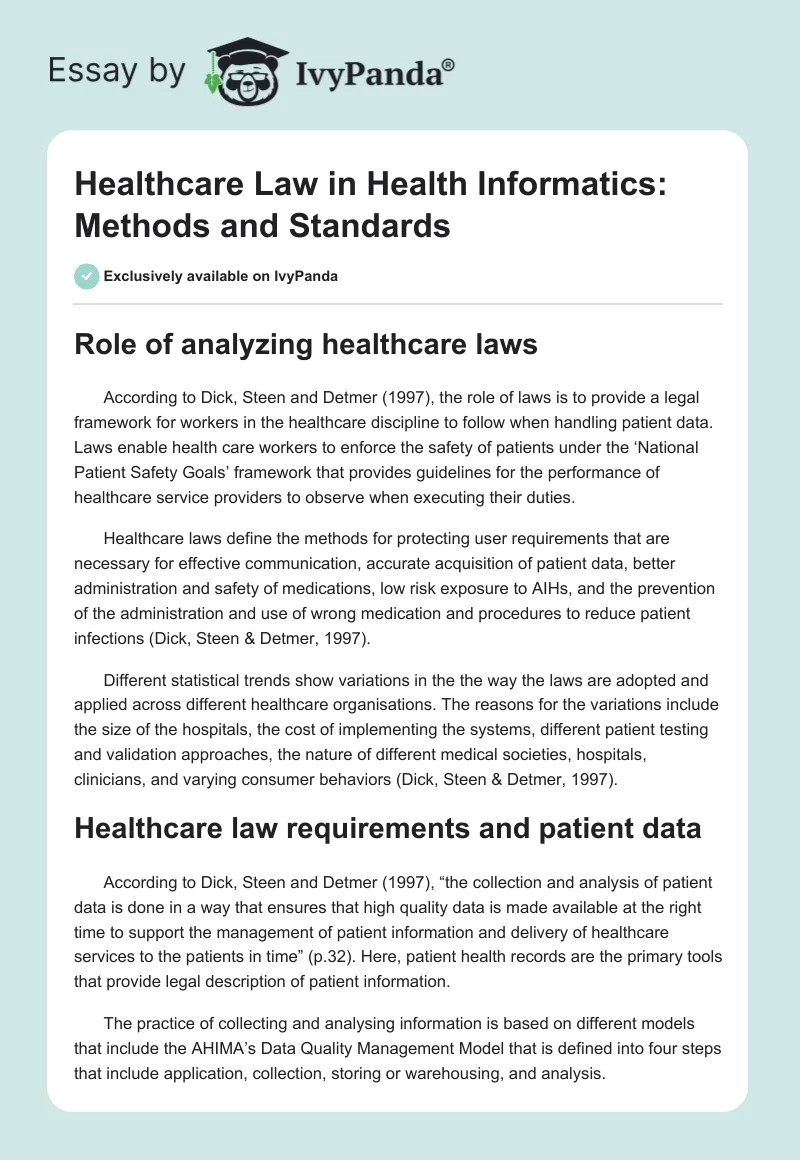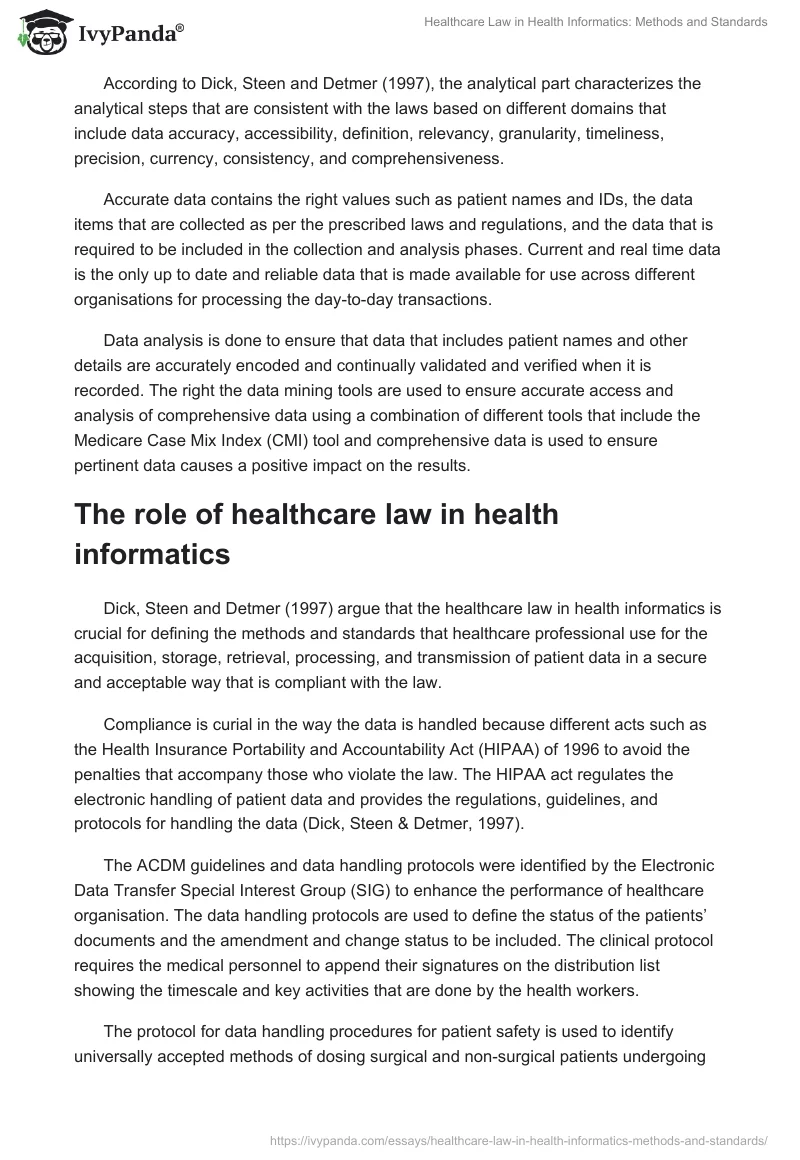Role of analyzing healthcare laws
According to Dick, Steen and Detmer (1997), the role of laws is to provide a legal framework for workers in the healthcare discipline to follow when handling patient data. Laws enable health care workers to enforce the safety of patients under the ‘National Patient Safety Goals’ framework that provides guidelines for the performance of healthcare service providers to observe when executing their duties.
Healthcare laws define the methods for protecting user requirements that are necessary for effective communication, accurate acquisition of patient data, better administration and safety of medications, low risk exposure to AIHs, and the prevention of the administration and use of wrong medication and procedures to reduce patient infections (Dick, Steen & Detmer, 1997).
Different statistical trends show variations in the the way the laws are adopted and applied across different healthcare organisations. The reasons for the variations include the size of the hospitals, the cost of implementing the systems, different patient testing and validation approaches, the nature of different medical societies, hospitals, clinicians, and varying consumer behaviors (Dick, Steen & Detmer, 1997).
Healthcare law requirements and patient data
According to Dick, Steen and Detmer (1997), “the collection and analysis of patient data is done in a way that ensures that high quality data is made available at the right time to support the management of patient information and delivery of healthcare services to the patients in time” (p.32). Here, patient health records are the primary tools that provide legal description of patient information.
The practice of collecting and analysing information is based on different models that include the AHIMA’s Data Quality Management Model that is defined into four steps that include application, collection, storing or warehousing, and analysis.
According to Dick, Steen and Detmer (1997), the analytical part characterizes the analytical steps that are consistent with the laws based on different domains that include data accuracy, accessibility, definition, relevancy, granularity, timeliness, precision, currency, consistency, and comprehensiveness.
Accurate data contains the right values such as patient names and IDs, the data items that are collected as per the prescribed laws and regulations, and the data that is required to be included in the collection and analysis phases. Current and real time data is the only up to date and reliable data that is made available for use across different organisations for processing the day-to-day transactions.
Data analysis is done to ensure that data that includes patient names and other details are accurately encoded and continually validated and verified when it is recorded. The right the data mining tools are used to ensure accurate access and analysis of comprehensive data using a combination of different tools that include the Medicare Case Mix Index (CMI) tool and comprehensive data is used to ensure pertinent data causes a positive impact on the results.
The role of healthcare law in health informatics
Dick, Steen and Detmer (1997) argue that the healthcare law in health informatics is crucial for defining the methods and standards that healthcare professional use for the acquisition, storage, retrieval, processing, and transmission of patient data in a secure and acceptable way that is compliant with the law.
Compliance is curial in the way the data is handled because different acts such as the Health Insurance Portability and Accountability Act (HIPAA) of 1996 to avoid the penalties that accompany those who violate the law. The HIPAA act regulates the electronic handling of patient data and provides the regulations, guidelines, and protocols for handling the data (Dick, Steen & Detmer, 1997).
The ACDM guidelines and data handling protocols were identified by the Electronic Data Transfer Special Interest Group (SIG) to enhance the performance of healthcare organisation. The data handling protocols are used to define the status of the patients’ documents and the amendment and change status to be included. The clinical protocol requires the medical personnel to append their signatures on the distribution list showing the timescale and key activities that are done by the health workers.
The protocol for data handling procedures for patient safety is used to identify universally accepted methods of dosing surgical and non-surgical patients undergoing invasive procedures to reduce health risks, improve the safety of medications, identify patients at risk, how to effectively communicate with care givers and to identify appropriate procedure verification processes and procedures (Dick, Steen & Detmer, 1997).
For instance to be Health Insurance Portability and Accountability Act (HIPAA) (HIPAA) compliant, the health institution must adhere to the HIPAA compliant requirements that include adhering to the training and development standards, employing IT professionals to management the information systems, passwords protection and updates, and above all, ensuing that the privacy rules are enforced adequately.
Adequate compliance to HIPAA requires compliance of administrative procedures that include data backups, disaster recovery plans, and formal mechanisms of data processing, security management practices, and effective incident handling techniques, implementation of physical and technical controls and safeguards, and use of technical security mechanisms.
Analysing patient data for compliance
Typically, one of the approaches of ensuring that patient data is analysed to ensure compliance is by enforcing automating compliance with the PHI policies. The Patient Health Information (PHI) provides that patient data should be kept confidential and secure to be assured that the handling procedures are consistent with the PHI data protection laws.
Among the “laws that organisations need to comply with include the data protection act that was created to ensure that patient data is kept private and confidential based on the eight principles of data protection” (Dick, Steen & Detmer, 1997). Under the “Data Protection Act 1998, the unlawful processing, or disclosure of personal data to a third party, is a criminal act” (Dick, Steen & Detmer, 1997).
The processing and analysis of personal data for the sake of compliance should be based on the eight principles of the data protection act that include lawful and fair processing, lawful access, observation of data processing laws in accordance with the rights of the affected person, observation of data integrity laws across national boundaries, and accurate and up to date use of personal data (Dick, Steen & Detmer, 1997).
Here, the processing ecosystem should be protected to make patient data safe in when being accessed, processed, and stored. For instance the HIPAA provides guidelines for the protection of patient data that covers the “healthcare providers, health plan administrators, healthcare clearinghouses, schools, and universities” (Dick, Steen & Detmer, 1997).
In summary, the standards for data protection are used to ensure entity authentication, audit access control, confidentiality, integrity, and compliance with the federal laws and regulations. Confidential data can only be revealed to the right party who can be authenticated to verify the legitimacy of their claims to access patient data so that the integrity of the data is not compromised.
Reference
Dick, R. S., Steen, E. B., & Detmer, D. E. (1997). The Computer-Based Patient Record: An Essential Technology for Health Care. New York: National Academies Press.


